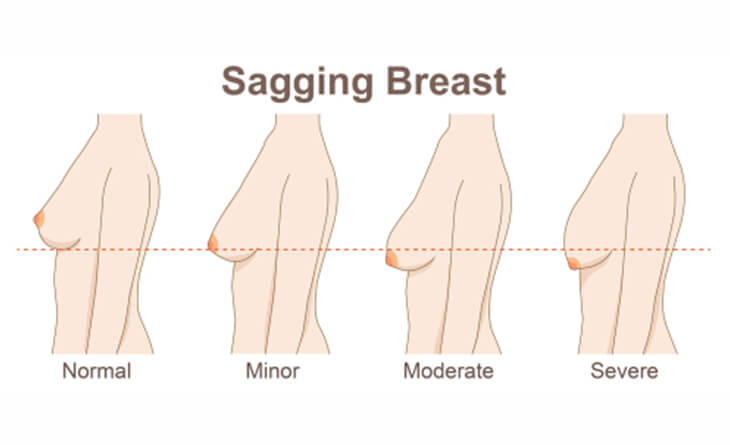Normal youthful breasts are firm with a rounded contour, the nipple being at the center of the breast mound. Breasts may lose their firmness and droop down under the influence of gravity due to ageing, deflation after breast feeding or significant weight loss. Many women are unhappy about their sagging breasts, loss of round contour / firmness and the empty appearance of the upper part of their breasts. Breast lift is a surgical procedure devised to lift and tighten breasts that have lost volume and are sagging.

Am I a good candidate for breast lift surgery?
You may be a good candidate for breast lift surgery if:
- You are bothered by the way your breasts sag or have lost shape and volume
- Your breasts have a flatter, elongated shape or are pendulous
- When unsupported, your nipples point downward or fall below the under-breast fold
- You have stretched skin and enlarged areolas
- One breast is lower than the other
Drooping of breasts is known as breast ptosis and based on the position of your nipples with respect to the fold under the breasts, it is categorized into 4 types.
Normal: where the nipple is situated above the breast fold with good volume both above and below nipples
Grade I: where nipple is situated at the level of the breast fold and above most of the lower pole breast volume.
Grade II: where the nipple is situated below the level of the breast fold but still above most of the lower pole breast volume.
Grade III: where the nipple is situated below the level of the breast fold and at/below most of the lower pole breast volume.
Pseudo-ptosis: where the nipple is situated above the IMF but breast tissue droops below the breast fold.
What are the important things to do before breast lift surgery?
The most important thing about planning your breast lift surgery is to choose the correct qualified Aesthetic plastic surgeon. More specifically, ensure that the chosen surgeon is routinely performing breast lift surgeries.
You must STOP the following medications approximately 2 weeks before surgery – blood thinners such as ecosprin, clopidogrel, warfarin etc, estrogen containing hormones, Vitamin E, ginseng, green tea, gingko balboa, garlic pearls, ayurvedic supplements. It is imperative that you completely stop smoking for a minimum of 1 week prior to your planned date of surgery as it can significantly increase your risk for anaesthesia as well as delay wound healing and increase your risk for post-surgery complications.
You will be advised a set of routine pre-operative investigations to ensure that you are fit for anaesthesia and surgery. A mammogram is also advisable prior to surgery to rule out any existing lumps or lesions in the breast. If you have a personal or family history of breast cancer, then a detailed baseline mammogram is mandatory to ensure absence of any existing lesion.

Surgery options
Normal breasts – sometimes, women with otherwise normal breasts are unhappy due to the loss of fullness in the upper part of their breasts (loss of upper pole fullness). Such patients can be effectively treated with breast augmentation alone.
Grade I Ptosis – They can be managed either with breast augmentation alone or Breast lift surgery. Some of them may require a combination of breast augmentation with some form of lifting of only the nipple-areola. (Peri-areolar pexy – Crescent or Donut)
Grade II and Grade III Ptosis – These patients will definitely require a formal Breast lift surgery. Some patients may also want an increase in their bust size and therefore may be offered an Augmentation mastopexy surgery i.e. simultaneous increase in the breast size by using a silicone implant AND a breast lift surgery.
Severe breast sagging is also commonly seen in patients after significant weight loss. In these cases, not only have the breasts lost tissue volume but the breast tissue and skin also do not have any elasticity. This group of patients therefore require more extensive procedures to tighten, reshape and lift the drooping tissue and skin.
Please discuss these options in detail with your qualified Aesthetic surgeon during consultation.
Incisions for Mastopexy
What to expect during recovery?
You will be advised to stay admitted in the hospital overnight after the surgery.
Breast lift surgery is NOT associated with much pain and most patients are comfortable immediately after surgery. Mild painkillers may be prescribed for a few days. You will be comfortable enough to walk around by the same evening. You will be advised to wear a well-fitting elastic bra whenever you are upright and walking for at least 4-6 weeks after surgery.
Post-op dressings are done every 4th/5th after surgery for 2 weeks. You can have a full body bath only after the dressings are stopped.
You can resume non-strenuous activities by 5-7 days after surgery. You may resume your routine work by 7-14 days after surgery. However, you may start bending, lifting hands above your head and exercises only 4 weeks after surgery.
The scars will be firm and pink for at least 6 weeks, after which they generally begin to fade and settle in 3 to 6 months.
Initially, the breasts may appear unnatural, lifted high up and firm to feel. However, with time the breasts will look and feel more natural. By 2-3 months after surgery, you can expect to see the final shape, size and feel of your lifted, firmer and more youthful breasts.
What can go wrong?
As with any surgical procedure, breast lift may be associated with various possible complications or unwanted effects. These may be as follows:
- Early Swelling, bruising and discomfort is expected.
- Some patients may develop a small collection of fluid (seroma) or blood clots (hematoma) in the breasts after surgery. These usually settle on their own. Rarely a needle aspiration may be necessary
- Wound breakdowns – This risk is greater in chronic smokers, diabetics, and with patients with very large breasts. In a majority of such cases, with a more prolonged period of dressings, the wound heals on its own. Rarely, the wound may need to be stitched up again to expedite the healing process.
- Reduced nipple sensation – happens in a few patients and recovers over 6 months to a year after surgery.
- Asymmetry – Minor differences in breast size are normal. Major asymmetry after surgery is very rare.
- Scar related problems – sometimes bunched up skin at the lower end of the incision pouts out (Dog-ear) and may require a minor procedure to remove it. In some cases, the scars may darken, thicken or stretch. Your surgeon will advise you appropriate creams or gels for such scars.
